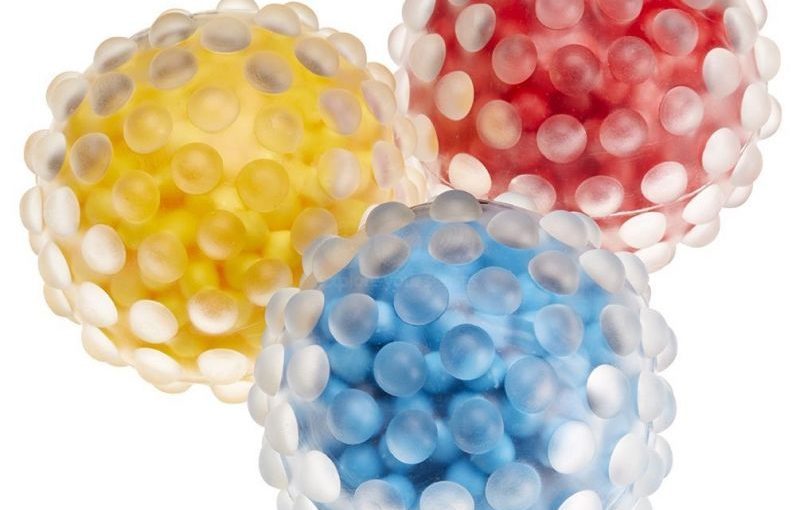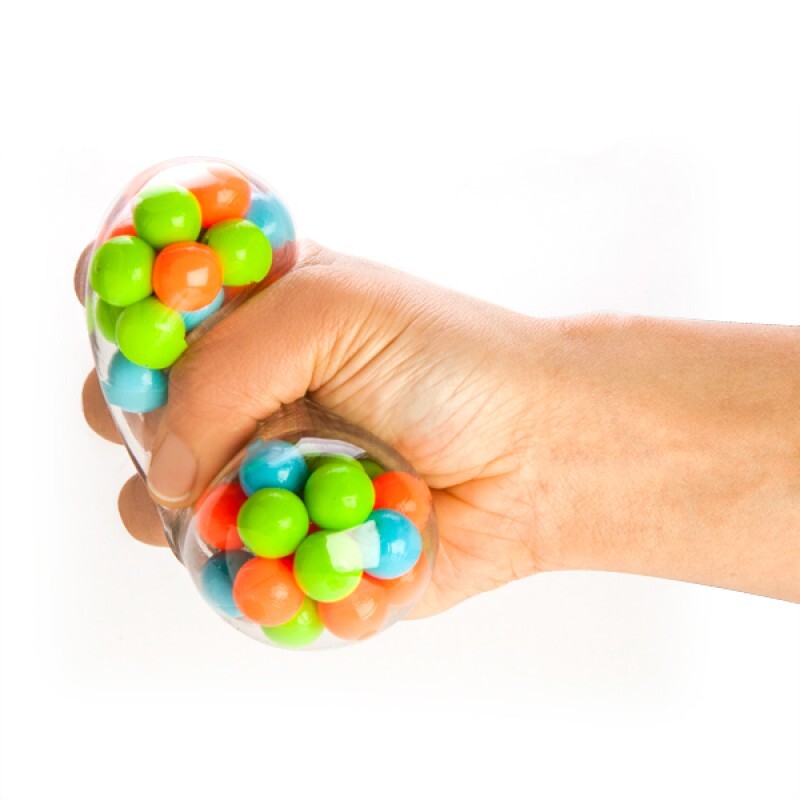The Benefits of Sensory Play with Balls
Sensory play with balls offers a universe of benefits for kids. Here’s why it’s so valuable:
- Encourages Fine Motor Skills: Ball sensory activities can promote the development of fine motor skills. When children grasp, squeeze, or throw a ball, they refine their dexterity and hand-eye coordination.
- Stimulates the Senses: Balls come in various textures and sizes, which can stimulate a child’s sense of touch. Bright colors and varying contours can also visually engage them, enhancing sensory awareness.
- Boosts Cognitive Development: As kids interact with different kinds of sensory balls, they learn about cause and effect. Understanding how balls bounce or respond to pressure can foster problem-solving abilities.
- Promotes Physical Exercise: Sensory ball play encourages kids to move. Throwing, catching, or rolling a ball helps with gross motor skills and physical fitness.
- Facilitates Social Skills: When engaged in group sensory ball activities, kids learn valuable social skills. They can practice sharing, taking turns, and collaborative play.
- Reduces Stress: The tactile nature of ball sensory play can be very calming for children. Squeezing stress balls, for instance, is known to help reduce anxiety and improve focus.
- Adaptable to All Abilities: Ball sensory play is inclusive and can be modified to suit children with varying levels of ability. This makes it an excellent tool for inclusive education and therapy.
By incorporating ball sensory play into a child’s routine, you can support their overall development in a fun and engaging way.
Essential Sensory Ball Types to Get Started
To dive into the world of ball sensory play, having the right kinds of sensory balls is crucial. They come in an array of textures, sizes, and functions to cater to various needs and preferences. Here’s a list of essential sensory ball types to get your child started:
- Textured Balls: These balls have surfaces with bumps, ridges, or other tactile elements. They’re excellent for sensory exploration and enhancing tactile feedback.
- Soft Balls: Ideal for younger kids, soft balls are gentle on the hands. They can be squeezed and manipulated easily, aiding in the development of grip strength.
- Squeaky Balls: The added sound element of a squeaky ball can captivate a child’s attention. They’re also helpful for auditory sensory stimulation.
- Transparent Balls: Balls that are see-through can be filled with colorful objects. This not only visual engages a child but also piques curiosity about the contents.
- Weighted Balls: These provide proprioceptive feedback, which can be soothing. They also help in muscle development and coordination.
- Glowing Balls: Balls that light up when bounced are great for visual tracking and can be especially fun in dimmer environments.
- Oversized Balls: Large balls encourage whole-body movement and are fantastic for gross motor skills development.
These sensory ball types form a good foundation for a sensory play kit. Select a variety and observe which ones your child gravitates towards most. Remember, the goal is to stimulate different senses and enhance a child’s developmental process in an enjoyable manner. Be mindful, however, to ensure the balls are age-appropriate, safe, and do not pose a choking hazard for younger children.
Age-Appropriate Sensory Ball Activities
Choosing age-appropriate activities is key to maximizing the benefits of ball sensory play. Here’s how you can tailor these activities for different age groups:
- Infants (0-1 year): For the youngest children, simple activities work best. Offer a variety of soft balls with different textures to grasp and explore. Gentle rolling of a ball towards the infant can stimulate crawling or reaching.
- Toddlers (1-3 years): Introduce balls that squeak or are slightly weighted to engage toddlers. Encourage them to throw or catch with soft balls, which can enhance fine and gross motor skills.
- Preschoolers (3-5 years): At this age, children can handle more complex tasks. Use transparent or glowing balls for hide-and-seek games to sharpen cognitive skills. Bigger, bouncy balls can promote active play.
- School-aged kids (6 years and above): Offer a mix of oversized and textured balls. Create obstacle courses or ball-based tag games that require strategizing, which can boost physical and social development.
Remember to always supervise children during ball sensory play and adjust activities to the child’s interest and ability. This ensures a safe and enjoyable experience for everyone involved.
How to Create a Sensory Ball Pit at Home
Creating a sensory ball pit at home can be a delightful addition to your child’s play area. Here’s a simple guide to help you set it up:
- Choose the Right Location: Select an area that’s safe and spacious enough for your child to play in. The room should be free from sharp objects and have a flat surface.
- Get a Ball Pit or Inflatable Pool: Purchase a child-friendly ball pit or use an inflatable pool. Ensure it’s sturdy and durable for regular use.
- Select a Variety of Sensory Balls: Fill the pit with various sensory balls, such as textured, soft, squeaky, and glowing balls. Consider the age and preferences of your child when picking the balls.
- Ensure Safety Measures: Make sure the ball pit is placed on a soft surface or use a mat underneath. Regularly check the balls for any signs of damage or wear.
- Set Clear Boundaries: Teach your child how to safely use the ball pit. Establish rules like no standing on the balls or no rough play inside the pit.
- Keep It Clean: Clean the balls and the pit regularly to maintain hygiene. Use non-toxic cleaners and allow ample time for drying.
Creating a sensory ball pit at home can offer endless hours of fun and developmental benefits. It’s a simple way to enhance your child’s sensory experience and encourage creative play. Just remember to prioritize safety and hygiene for the best playtime experience.
Sensory Ball Games for Individual and Group Play
Sensory ball games offer creative ways to enhance a child’s learning and social interactions. Ideal for both individual and group settings, these games make playing with balls an educational and social experience.
Individual Sensory Ball Exercises
For solo play, sensory balls can be used to improve focus and self-regulation. Here are some individual activities:
- Balance and Catch: Children try balancing a ball on their hand, then toss and catch it.
- Sensory Exploration: Kids explore different ball textures, identifying and describing each one.
- Bounce to Beat: Bouncing balls in rhythm with music helps with coordination and auditory processing.
These exercises cater to developing independence and concentration, key for individual growth.
Group Sensory Ball Games
When playing in groups, ball sensory games foster teamwork and communication. Some fun group games include:
- Pass the Ball: Kids sit in a circle and pass different sensory balls, sharing what they feel.
- Ball Relay: Teams move a ball through an obstacle course, enhancing cooperation and strategy skills.
- Glowing Ball Hunt: Players find glowing balls in a dark room, which can be thrilling and engaging.
Group games like these support the development of social skills and group dynamics, all while having a ball! Remember to mix different ball sensory types to keep the experiences fresh and attention-grabbing.
Incorporating Learning with Ball Sensory Activities
Utilizing ball sensory activities for educational purposes can enhance a child’s learning journey. Here’s how to integrate these activities with learning objectives:
- Color and Shape Identification: Use balls of different colors and shapes to teach these basic concepts. Ask children to find and name each shape or color.
- Counting and Numbers: Encourage children to count balls as they play. Grouping balls by number can also introduce basic math skills.
- Alphabet and Spelling: Balls labeled with letters can help in teaching the alphabet. Create games where children spell words using ball letters.
- Science Exploration: Explain concepts of gravity and motion by observing how balls bounce and roll. This makes science tangible and fun.
- Language Skills: Describe the textures and sensations of different balls to build vocabulary. Turn sensory ball play into a storytelling session with each bounce.
- Emotional Intelligence: Use ball play as an opportunity to discuss feelings. A smiley face on a ball can prompt a discussion about happiness, for instance.
Each activity should cater to the child’s age and developmental stage. By integrating learning with play, children engage more deeply and retain information better. Always ensure these activities are done in a safe environment. Monitor the interaction with sensory balls to prevent any risks.
Safety Tips for Ball Sensory Play
Ensuring safe play with sensory balls is crucial for a child’s well-being. Here are several safety tips to keep in mind:
- Supervise Playtime: Always watch children during ball sensory play to prevent mishaps.
- Check for Damage: Regularly inspect sensory balls for wear and tear to stave off choking hazards.
- Choose Age-Suitable Balls: Pick balls that match a child’s age and abilities to ensure they are appropriate and safe.
- Avoid Hard Surfaces: Place a soft mat or carpet underneath the play area to cushion falls.
- No Small Parts: For younger kids, ensure balls do not contain small parts that could pose choking risks.
- Ball Size Matters: Avoid balls that are too small for younger children as they can be a swallowing risk.
- Teach Safe Play: Instruct kids on how to play safely, such as not throwing balls at others.
- Keep It Clean: Clean sensory balls with safe, non-toxic products to maintain hygiene and good health.
By following these safety tips, caregivers can create a secure environment where kids can enjoy the developmental benefits of ball sensory play without unnecessary risks. Remember, the priority is to offer supportive and protective experiences during sensory playtime.
Ideas for Making DIY Sensory Balls
Creating your own DIY sensory balls is a cost-effective and fun way to enhance your child’s sensory play experience. Here’s how you can make several types of homemade sensory balls:
- Rice-Filled Balloons: Fill balloons with rice to create a textured ball that is easy to squeeze and manipulate. This can help to strengthen hand muscles and boost tactile feedback.
- Glitter and Water Balls: Use transparent balloons, fill them with water, and add glitter or small colorful beads. These sparkling balls are perfect for visual stimulation and can be quite mesmerizing.
- Sand-Textured Balls: Adding fine sand to balloons gives a unique texture for little hands to explore. It’s a simple way to introduce a new sensory experience.
- Fabric-Covered Balls: Take old socks or fabric scraps with different textures and cover balls with them. They’re great for enhancing the sense of touch.
- Bean Bag Balls: Sew small fabric squares filled with beans or lentils to form a soft, squishy ball ideal for throwing and catching games.
- Noise-Making Balls: Place small bells or beads inside a balloon before inflating it to make a ball that jingles or rattles when moved.
- Aroma Therapy Balls: Add a few drops of child-safe essential oils to cotton balls, and place them inside balloons. As the balls are squeezed, they release a gentle scent that can be calming.
By making your own sensory balls, you not only create an enjoyable craft activity to share with your kids but also provide them with a personalized sensory play tool. Always ensure that the materials you use are safe and suitable for your child’s age, and supervise their play to prevent any risks associated with homemade toys.



